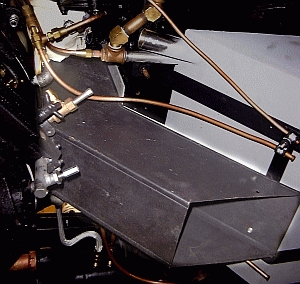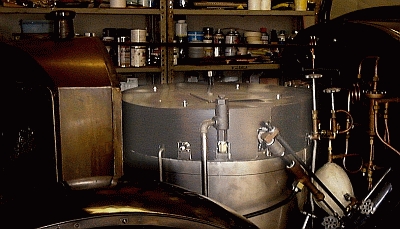|
 The smokebox
is designed as a "cap within a cap". Shown at the right is a smokebox nearly
ready to be installed to the top of a Stanley boiler. The square
section at the lower right serves to connect the smokebox with the exhaust
duct that is located in front of the firewall. The circular hole
offset from the center of the smokebox is for the "trap door" (shown with
the door closed in the photograph). Around the perimeter of the
smokebox are various size openings which allow piping to pass through. The smokebox
is designed as a "cap within a cap". Shown at the right is a smokebox nearly
ready to be installed to the top of a Stanley boiler. The square
section at the lower right serves to connect the smokebox with the exhaust
duct that is located in front of the firewall. The circular hole
offset from the center of the smokebox is for the "trap door" (shown with
the door closed in the photograph). Around the perimeter of the
smokebox are various size openings which allow piping to pass through.
The outside cap or shell of the
smokebox is only slightly larger than the diameter of the boiler. This
allows the smokebox to slip tightly over the boiler and form a semi-tight
seal. This cap also includes the transition ductwork necessary to
connect the smokebox to the exhaust duct. Inside the transition
ductwork is a short length of copper tubing (not shown in the photograph)
that extends down the center of the ductwork and is the discharge for the
stack blower (see the discussion on the stack blower for information related
to how the stack blower is used).
Inside the outer cap or shell is an
inner, smaller, cap or shell. This cap is several inches smaller in
diameter and height from the outer cap. The diameter of the inner cap
is such that it can sit over and encapsulate all of the boiler's flue tubes
as they extend through the top of the boiler. The height of the inner
cap is such that it allows several inches of insulation between the the caps
as well as allows the outer cap to slip over the exterior of the boiler
while the inner cap rests on the flue sheet to hold the smokebox in place.
As shown in the photograph, the difference in size between the two caps
allows insulation to be placed between the outer surface of the inner cap
and the inner surface of the outer cap (the photograph shows insulation
already in place for the top of the smokebox with the insulation for the
circular side wall of the smokebox yet to be cut for the openings around the
perimeter and installed. The inner cap has an opening that matches up
with the exhaust duct portion of the outside cap of the smokebox. The
two caps are bolted together to form a single unit.
 Combustion gasses
exiting the boiler's flue tubes enters the inner cap of the smokebox.
There all the gasses from all the flues are collected together and directed
towards the opening in the smokebox that connects to the exhaust duct.
Mounted to the front center of the firewall is the exhaust duct which
travels down the firewall and under the car. The exhaust duct carries
the combustion gasses collected in the smokebox down below the car's water
tank and discharges them into the atmosphere. As the exhaust duct
makes its way to the underside of the water tank it is directed towards the
back of the car and shaped such that when the car is in motion the air
passing across the end of the exhaust duct causes a venturi effect on the
duct to actually draw gasses from the duct and mix them with the air. Combustion gasses
exiting the boiler's flue tubes enters the inner cap of the smokebox.
There all the gasses from all the flues are collected together and directed
towards the opening in the smokebox that connects to the exhaust duct.
Mounted to the front center of the firewall is the exhaust duct which
travels down the firewall and under the car. The exhaust duct carries
the combustion gasses collected in the smokebox down below the car's water
tank and discharges them into the atmosphere. As the exhaust duct
makes its way to the underside of the water tank it is directed towards the
back of the car and shaped such that when the car is in motion the air
passing across the end of the exhaust duct causes a venturi effect on the
duct to actually draw gasses from the duct and mix them with the air.
The exhaust duct for
a Model 735 Stanley is shown at the left. The photograph was taken from
behind and below the front left wheel looking towards the exhaust duct. The
water tank is the gray tank in the photo and sits in its mounting straps
which are secured to the car's frame. The burner is along the left
side of the photograph. The steam siphon piping is at the top center
of the photograph. Two boiler blow-down discharge pipes are seen in
the photo, secured to the water tank support brackets, and running nearly
parallel to the exhaust duct. A third boiler blow-down discharge can
be seen just protruding below the other side of the exhaust duct.
In the top of the smokebox is a trap
door. The purpose of the trap door is two-fold. First it allows
the escape of any combustible gasses from the burner or pilot that may
accumulate and be trapped in the smokebox. When the burner is shut
down by the steam automatic (or burner fuel valve when that is closed) there
will be some fuel in the vaporizer tube that becomes vaporized but with no
fresh fuel pushing it out of the vaporizer it will flow out of the vaporizer
tube slowly and enter the mixing tubes. The heat of the boiler will
cause convection air currents through the flue tubes and draw in the vapors.
Normally the pilot will burn them off but if the pilot has gone out for some
reason the gasses will pass through the burner grate and into the boiler
flues. These gasses will find their way to the top of the boiler via
the flues and into the smokebox. If the car is not in motion the
gasses in the smokebox will not be drawn out and thus some small quantity of
combustible gas may accumulate in the smokebox. Opening the smokebox
when stopping the car after a long drive, and especially before bringing a
lighted blow torch near the boiler, will allow any accumulated combustible
gasses to be released.
The second function of the trap door
is to allow the easy escape of combustion gasses when firing up the car.
The burner will be producing copious amounts of combustion gasses and heat.
These gasses once in the smokebox will have trouble passing down and out the
exhaust duct since the gasses are both hotter and lighter than the air.
Thus opening the trap door during firing up allows the combustion gasses of
the burner and pilot an easy passage through the boiler flue tube and into
the atmosphere. Once steam pressure has been raised and the car is
ready to be moved the trap door can be closed and the hood lowered.
When the car has been driven for awhile it is good practice on stopping for
an extended time to open the hood and trap door to allow any accumulated
gasses to escape. After being open for fifteen minutes or so the trap
door can be closed to help maintain the heat in the boiler. |

 The smokebox
is designed as a "cap within a cap". Shown at the right is a smokebox nearly
ready to be installed to the top of a Stanley boiler. The square
section at the lower right serves to connect the smokebox with the exhaust
duct that is located in front of the firewall. The circular hole
offset from the center of the smokebox is for the "trap door" (shown with
the door closed in the photograph). Around the perimeter of the
smokebox are various size openings which allow piping to pass through.
The smokebox
is designed as a "cap within a cap". Shown at the right is a smokebox nearly
ready to be installed to the top of a Stanley boiler. The square
section at the lower right serves to connect the smokebox with the exhaust
duct that is located in front of the firewall. The circular hole
offset from the center of the smokebox is for the "trap door" (shown with
the door closed in the photograph). Around the perimeter of the
smokebox are various size openings which allow piping to pass through. Combustion gasses
exiting the boiler's flue tubes enters the inner cap of the smokebox.
There all the gasses from all the flues are collected together and directed
towards the opening in the smokebox that connects to the exhaust duct.
Mounted to the front center of the firewall is the exhaust duct which
travels down the firewall and under the car. The exhaust duct carries
the combustion gasses collected in the smokebox down below the car's water
tank and discharges them into the atmosphere. As the exhaust duct
makes its way to the underside of the water tank it is directed towards the
back of the car and shaped such that when the car is in motion the air
passing across the end of the exhaust duct causes a venturi effect on the
duct to actually draw gasses from the duct and mix them with the air.
Combustion gasses
exiting the boiler's flue tubes enters the inner cap of the smokebox.
There all the gasses from all the flues are collected together and directed
towards the opening in the smokebox that connects to the exhaust duct.
Mounted to the front center of the firewall is the exhaust duct which
travels down the firewall and under the car. The exhaust duct carries
the combustion gasses collected in the smokebox down below the car's water
tank and discharges them into the atmosphere. As the exhaust duct
makes its way to the underside of the water tank it is directed towards the
back of the car and shaped such that when the car is in motion the air
passing across the end of the exhaust duct causes a venturi effect on the
duct to actually draw gasses from the duct and mix them with the air.